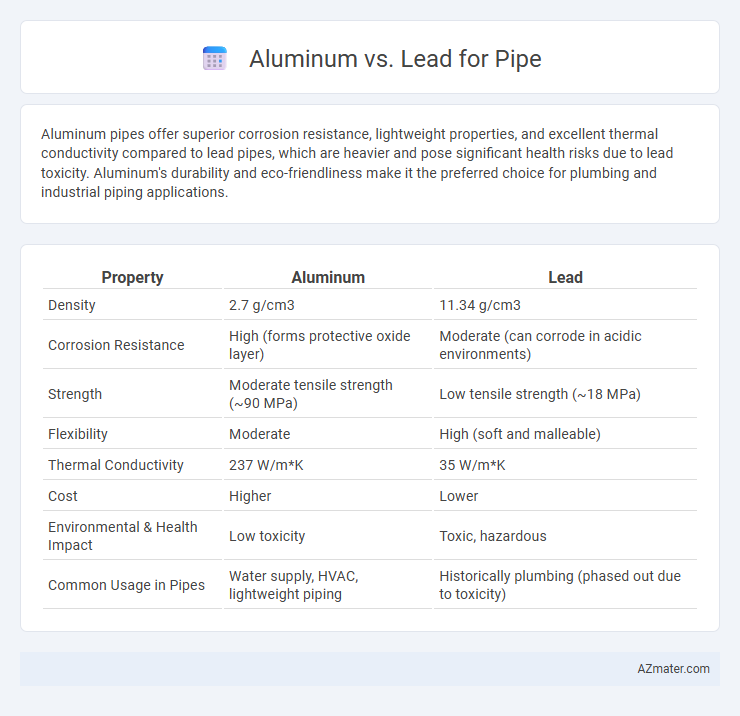Aluminum pipes offer superior corrosion resistance, lightweight properties, and excellent thermal conductivity compared to lead pipes, which are heavier and pose significant health risks due to lead toxicity. Aluminum's durability and eco-friendliness make it the preferred choice for plumbing and industrial piping applications.
Table of Comparison
| Property | Aluminum | Lead |
|---|---|---|
| Density | 2.7 g/cm3 | 11.34 g/cm3 |
| Corrosion Resistance | High (forms protective oxide layer) | Moderate (can corrode in acidic environments) |
| Strength | Moderate tensile strength (~90 MPa) | Low tensile strength (~18 MPa) |
| Flexibility | Moderate | High (soft and malleable) |
| Thermal Conductivity | 237 W/m*K | 35 W/m*K |
| Cost | Higher | Lower |
| Environmental & Health Impact | Low toxicity | Toxic, hazardous |
| Common Usage in Pipes | Water supply, HVAC, lightweight piping | Historically plumbing (phased out due to toxicity) |
Introduction: Aluminum vs Lead Pipes Overview
Aluminum pipes offer lightweight, corrosion-resistant properties ideal for modern plumbing and industrial applications, contrasting with lead pipes known for their durability but associated health risks due to lead toxicity. Lead pipes, historically used for water distribution, are being phased out in favor of safer materials like aluminum, which does not leach harmful substances into water. The comparison between aluminum and lead pipes highlights a critical shift towards safer, more sustainable infrastructure materials.
Historical Use of Aluminum and Lead in Plumbing
Lead pipes have been historically favored for plumbing due to their malleability and resistance to corrosion, dating back to Roman aqueducts. Aluminum, introduced in plumbing during the 20th century, offered a lightweight and corrosion-resistant alternative but saw limited use compared to lead. The shift away from lead pipes emerged from health concerns over lead poisoning, leading to restrictions and the gradual replacement with safer materials like copper and plastic.
Physical Properties: Strength and Durability
Aluminum pipes offer high strength-to-weight ratio and exceptional corrosion resistance, making them durable in various environments. Lead pipes, while dense and malleable, are prone to corrosion and deformation over time, reducing their long-term durability. The superior tensile strength of aluminum enhances its performance in pressure applications compared to lead's relatively low mechanical strength.
Health and Environmental Impacts
Aluminum pipes offer superior corrosion resistance compared to lead, reducing the risk of toxic metal leaching into drinking water and posing fewer health hazards such as lead poisoning. Lead pipes are known for their detrimental effects on human health, contributing to neurological damage, especially in children, and persistently contaminate soil and water sources, causing long-term environmental damage. Environmentally, aluminum is more sustainable due to its recyclability and lower ecological footprint, whereas lead mining and corrosion result in hazardous waste and pollution.
Corrosion Resistance and Longevity
Aluminum pipes exhibit superior corrosion resistance compared to lead pipes due to their naturally forming oxide layer that prevents rust and degradation. Lead pipes are highly susceptible to corrosion, leading to leaching of toxic lead into water systems, which poses significant health risks. Consequently, aluminum pipes offer greater longevity and are preferred in plumbing applications requiring durability and safety.
Installation and Maintenance Considerations
Aluminum pipes offer lightweight properties that simplify installation, reducing labor time and effort compared to heavy lead pipes. Aluminum's corrosion resistance minimizes maintenance frequency, whereas lead pipes require regular inspection and potential replacement due to toxicity and degradation concerns. The ease of handling and durability of aluminum make it a preferred choice for long-term plumbing solutions with lower maintenance costs.
Cost Comparison: Aluminum vs Lead Pipes
Aluminum pipes typically cost more upfront than lead pipes but offer longer-term savings due to their durability and corrosion resistance, reducing maintenance expenses. Lead pipes are cheaper initially but present higher health and environmental remediation costs, along with potential legal liabilities from lead contamination. Considering total lifecycle expenses, aluminum pipes provide a more cost-effective solution despite higher initial investment.
Regulatory Standards and Legal Restrictions
Lead pipes face stringent regulatory standards due to their toxic properties, with many countries banning or limiting their use under laws such as the U.S. Safe Drinking Water Act and the European Union's Drinking Water Directive. Aluminum pipes, classified as non-toxic and corrosion-resistant, generally meet regulatory requirements for potable water systems without significant legal restrictions. Compliance with regulations like NSF/ANSI 61 certification is essential for aluminum pipes in plumbing to ensure safe contact with drinking water.
Common Applications in Modern Construction
Aluminum pipes are commonly used in HVAC systems and water supply lines due to their lightweight nature and corrosion resistance, making them ideal for modern construction projects requiring durability and ease of installation. Lead pipes, historically prevalent in plumbing, are now largely restricted because of health risks, yet they remain in use for certain specialized applications such as radiation shielding or soundproofing in construction. The preference for aluminum over lead in contemporary building practices is driven by sustainability standards and regulatory compliance promoting safer and more efficient materials.
Future Trends in Pipe Material Selection
The future of pipe material selection is shifting towards aluminum due to its lightweight nature, corrosion resistance, and recyclability, making it ideal for sustainable infrastructure projects. Lead pipes are being phased out globally because of health risks associated with lead exposure and stricter environmental regulations. Advances in aluminum alloy technology are enhancing durability and cost-efficiency, positioning aluminum as the preferred choice in modern plumbing and industrial applications.

Infographic: Aluminum vs Lead for Pipe
 azmater.com
azmater.com